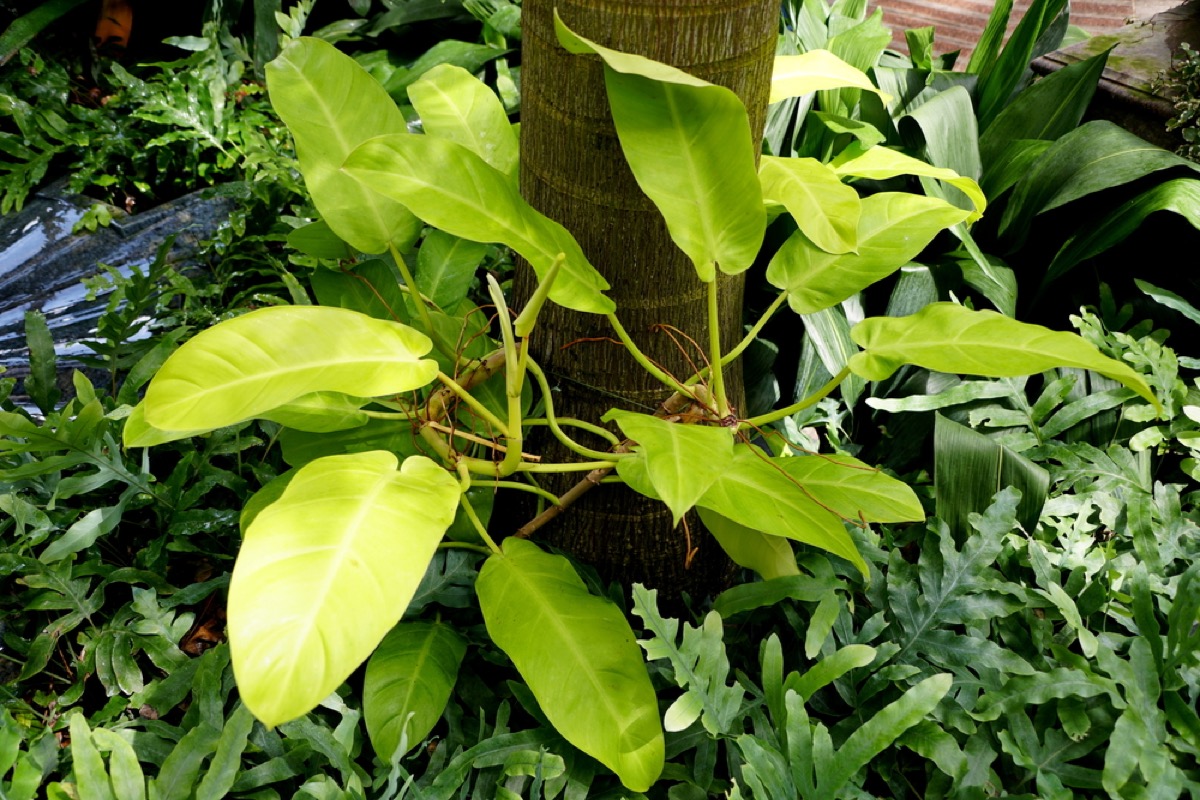Are you looking to add a vibrant touch of color to your indoor garden? Enter the Lemon Lime Philodendron – an eye-catching, easy-to-grow plant that will brighten any space with its unique, electric green hue. In the world of houseplants, propagating your favorites allows you to enjoy the beauty of the same species repeatedly while also saving money. The good news is that propagating Lemon Lime Philodendron is a relatively simple process, achievable by even the most amateur of gardeners.
In this article, we’ll guide you through the precise steps to ensure successful propagation of your Lemon Lime Philodendron. With attention to detail and a little patience, you’ll soon find yourself surrounded by stunning, healthy plants. By understanding the basics of this process, including the ideal cutting technique and care requirements, you’ll embark on a fulfilling journey that transforms your indoor space into a verdant paradise.
Lemon Lime Philodendron Overview
Lemon Lime Philodendron is a vibrant, colorful houseplant that features stunning, neon-yellow and green leaves. This unique plant adds a touch of tropical charm to any living space and can be an excellent addition to your plant collection. Gaining popularity for its low maintenance and hardy nature, Lemon Lime Philodendron is perfect for both experienced and novice plant enthusiasts.
Native to Central and South America, these plants thrive in warm, humid conditions. They are easy to grow and care for, requiring only a few basic care guidelines to flourish. Some key aspects of Lemon Lime Philodendron care include:
- Adequate lighting: Bright, indirect light is ideal. Avoid placing your plant in direct sunlight, as it can cause the leaves to scorch.
- Proper watering: Maintain evenly moist soil, but not soaked. Allow the top inch of soil to dry out between waterings.
- Moderate humidity: Mist leaves regularly or use a humidifier to replicate its natural environment.
One of the most appealing aspects of the Lemon Lime Philodendron is its versatility. It can either climb up a support like a trellis or be trimmed to maintain a bush-like appearance. By keeping your plant pruned, you can maintain more compact growth, creating a stunning focal point in your home.
One of the best parts about owning a Lemon Lime Philodendron is the ease with which you can propagate it. Propagation is a simple process that allows you to create more plants from your existing one, making it an excellent option for sharing with friends and family. A popular method for propagating these plants is via stem cuttings, which can be placed in water to root before being transferred to soil.
In summary, the Lemon Lime Philodendron is a beautiful, low-maintenance plant that brings a pop of color to any space. With proper care and attention, this vibrant houseplant will thrive and provide a stunning accent piece in your home.
Propagation Methods
Lemon Lime Philodendron can be propagated through different methods like stem cuttings and air layering. These techniques allow gardeners to grow new plants without spending much money.
Stem Cuttings
Stem cuttings is a popular and relatively easy method to propagate your Lemon Lime Philodendron. To begin, choose a healthy stem on the mother plant that’s at least 4-6 inches long and has a few leaves. The stem should be green, firm, and free from damage, pests, or diseases. Using a clean, sharp knife, cut the stem just below a node.
Once you have your stem, you can choose to root it in either water or moist soil. If you decide to root in water, place the cut end of the stem in a container filled with clean water, ensuring that at least one node is submerged. Change the water regularly to keep it fresh and promote root growth.
On the other hand, if you prefer to root in soil, use a well-draining potting mix to fill a small container. Optionally, you can dip the cut end of the stem in rooting hormone powder to encourage faster root development. Bury the node area in the soil, and make sure to keep the soil consistently moist but not soaking wet. Place the container in a bright spot away from direct sunlight, and in a few weeks, your stem cutting should start developing roots.
Air Layering
Another method to propagate Lemon Lime Philodendron is through air layering. This technique involves rooting the stem while it’s still attached to the mother plant. First, select a healthy stem with mature leaves, and using a clean knife, make a shallow upward diagonal cut about one-third of the way through the stem just below a node.
Next, wrap a small piece of damp sphagnum moss around the cut, making sure the entire exposed area is covered. To keep the moss in place, wrap it with plastic wrap or use a clear plastic bag, creating a mini greenhouse. Use twine or twist ties to secure the plastic around the stem.
Place the bag-wrapped stem in a location with bright, indirect light, and maintain the moisture in the sphagnum moss by occasionally misting it with water. After a few weeks, roots should start to grow within the moss. Once a healthy root system has developed, you can carefully remove the new plant from the mother plant and pot it into a separate container with fresh potting soil.
Preparing for Propagation
Materials Needed
To propagate a Lemon Lime Philodendron successfully, gather the following materials:
- A healthy mother plant
- Clean, sharp scissors or pruners
- A container for water or a pot with moist soil, depending on your preferred method
- Optional: rooting hormone
These materials will help you propagate the plant with minimal stress or damage to both the mother plant and the cuttings.
Choosing the Right Time
Propagation should ideally take place during spring or summer, when the Lemon Lime Philodendron is most active in terms of growth. This increases the chances of successful rooting and overall health for the new plant.
Follow these steps to prepare for propagating your Lemon Lime Philodendron:
- Select a healthy mother plant: Make sure the plant you’re taking cuttings from is in good condition, free of pests, and exhibiting healthy growth.
- Determine the best time for propagation: As mentioned, spring or summer are ideal for propagating as this is when the plant is most active.
- Gather your materials: Having your scissors or pruners, container, rooting hormone (optional), and a suitable place for keeping the cutting during the rooting process will make propagation stress-free and efficient.
By gathering the necessary materials and choosing the right time for propagation, you will be well-prepared to propagate your Lemon Lime Philodendron with confidence and success.
How to Propagate with Stem Cuttings
Taking the Cutting
When propagating lemon lime philodendron with stem cuttings, you’ll want to start by choosing a healthy stem that is at least 4-6 inches long and has a few leaves. Ensure the chosen stem is green, firm, and free from any damage, pests, or diseases. Using a clean, sharp knife, carefully cut the stem just below a node. Remember, a node is the small bump or protrusion on the stem where the leaves attach 1.
Rooting the Cutting
After taking your cutting, you have two options for rooting it: either in water or directly in soil. If rooting in water, place the cut end of the stem in a container filled with water, ensuring no leaves are submerged. Place the container in a spot with bright, indirect sunlight 2. Change the water every few days to keep it fresh and prevent bacterial growth.
For rooting in soil, follow these steps:
- Prepare a small pot with well-draining potting soil, leaving about an inch of space from the soil to the rim of the pot.
- Moisten the soil.
- Use your finger to create a hole in the soil.
- Insert the cut end of the stem into the hole, ensuring any roots or nodes are covered by the soil.
- Press the soil gently around the cutting to secure it in place.
Place the pot with the cutting in a location with bright, indirect sunlight and maintain consistently moist soil throughout the rooting process 3.
Planting the Cutting
Once your cutting has developed a healthy root system, it’s time to plant it. If you rooted your cutting in water, gently remove it from the container and plant it in a pot filled with well-draining potting soil. If your cutting was rooted in soil, simply transfer it to a larger pot that will accommodate its growing root system.
After transplanting the cutting, make sure to place the new plant in a spot with bright, indirect sunlight, and continue to keep the soil consistently moist as the lemon lime philodendron establishes itself in its new environment 4.
In summary, propagating lemon lime philodendron with stem cuttings is a simple and effective method for creating new plants. By carefully selecting and cutting healthy stems, then rooting and planting them, you can enjoy additional lemon lime philodendron plants in your home or garden.
How to Propagate with Air Layering
Selecting the Branch
When planning to propagate your lemon lime philodendron using air layering, start by selecting a healthy branch. Look for a firm, green branch with numerous leaves, free from damage, pests, or diseases. The branch should ideally be at least 4-6 inches long. Once you’ve picked a suitable branch, ensure that it can easily bend without breaking.
Creating the Air Layer
Follow these steps to create the air layer:
- Identify a node halfway up the selected branch.
- With a sharp knife, make an upward 1-inch cut at the node, being careful not to sever the branch entirely.
- Prop the cut open using a small stick or toothpick, ensuring it remains open for the air layering process.
- Apply rooting hormone to the cut area to encourage root development.
- Wrap a handful of moist sphagnum moss around the cut, forming a ball around it.
- Secure the moss ball by wrapping it with plastic wrap, twisting the ends to seal it, and securing it with a rubber band or string. Make sure the moss remains moist throughout the process.
Separating and Planting
After 4-6 weeks, you should see new roots developing within the moss ball. Once sufficient roots are visible, follow these steps:
- Carefully remove the plastic wrap and moss to expose the new roots.
- Using a sharp, clean knife, fully separate the rooted branch from the original plant just below the new roots, ensuring not to damage them.
- Prepare a pot with well-draining soil, and gently plant the rooted branch in it, making sure the new roots are fully covered by the soil.
- Water thoroughly and place the pot in a location with bright, indirect light.
By following these steps, your lemon lime philodendron will grow successfully through air layering. Ensure to provide proper care and maintenance for your propagated plant to thrive.
Post-Propagation Care
Ideal Environment
Creating the ideal environment is essential for the newly propagated Lemon Lime Philodendron. It thrives in bright, indirect sunlight, so place your plant near a window that receives plenty of natural light but avoids direct sunlight. Avoid positioning the plant near hot or cold drafts, as extreme temperature fluctuations may stress the plant. Philodendrons prefer a consistent temperature range between 65-80°F (18-27°C) throughout the day.
Watering
Appropriate watering techniques are crucial in ensuring the success of the propagation process. Keep the soil consistently moist without allowing it to become too soggy or bone dry. You can achieve this by watering the plant when the top inch of the soil feels dry to the touch. It’s important not to overwater or allow water to sit in the saucer, as this may lead to root rot.
Fertilizing
During the growing season, typically between spring and summer, you should provide your Lemon Lime Philodendron with additional nutrients by fertilizing it once every month. Use a balanced, water-soluble fertilizer diluted to half the recommended strength. Refrain from fertilizing in the winter months, as this is the plant’s dormant period.
In summary, ensuring a suitable environment, proper watering, and timely fertilization are key factors to fostering vibrant and healthy growth in newly propagated Lemon Lime Philodendrons. With the right care, your plant is bound to thrive and fill your space with its lively foliage.
Troubleshooting Propagation Problems
When propagating lemon lime philodendron, you may encounter some issues that can hinder the success of your plant cuttings. Let’s discuss a few common problems and their solutions.
Root Rot
Root rot is a common issue when propagating plants in water. To prevent root rot:
- Use clean containers and fresh water.
- Change the water every few days.
- Avoid over-fertilizing.
- Remove any unhealthy or dead leaves and roots.
If you notice rot on the cuttings, trim away the affected area and dip the tip in a rooting hormone before placing it back in the water.
Yellowing Leaves
Yellowing leaves can indicate different issues, including:
- Over-watering, in which case you should reduce the water for your cutting.
- Nutrient deficiency, which can be resolved by using a diluted liquid fertilizer.
- Pests or diseases, which may require removing the affected leaves or treating with a suitable pesticide.
Slow or No Root Growth
Sometimes, cuttings might fail to develop roots or take an unusually long time for rooting. Possible causes and solutions include:
- Inadequate light exposure: Ensure the cuttings receive bright, indirect light.
- Temperature extremes: Maintain a consistent temperature between 65 and 75°F (18-24°C).
- Lack of rooting hormone: Use a rooting hormone to boost root growth.
Tips for Successful Propagation
To maximize the chances of successful propagation, follow these recommendations:
- Select a healthy stem that’s at least 4-6 inches long, with a few leaves, green and firm.
- Use clean, sharp tools for cutting and pruning.
- Cut the stem just below a node for better rooting.
- Provide adequate light, air circulation, and proper room temperature.
By addressing these propagation problems and following the tips above, your lemon lime philodendron cuttings have a higher chance of growing into healthy, thriving plants.
Helpful Video

My name is Daniel Elrod, and I have been houseplant love ever since I was 17. I love how much joy they bring to any room in the home. I’ve always been amazed at how a few pots of flowing leaves can turn a drab and sterile office into an inviting place where people love to work at.




















































































































































